Procurement and Supply Chain
VerifiedAdded on 2023/04/20
|10
|2565
|275
AI Summary
This document analyzes the procurement and supply chain challenges faced by Sapphire Energy and AusCotton. It provides recommendations to improve the current systems and enhance efficiency. The case studies highlight issues such as faulty procurement systems, high inventory and carrying expenses, imperfect demand forecasts, and disorganized transport services. The paper suggests careful supplier selection, negotiation on various parameters, improved demand forecasting, and effective strategies for growth.
Contribute Materials
Your contribution can guide someone’s learning journey. Share your
documents today.
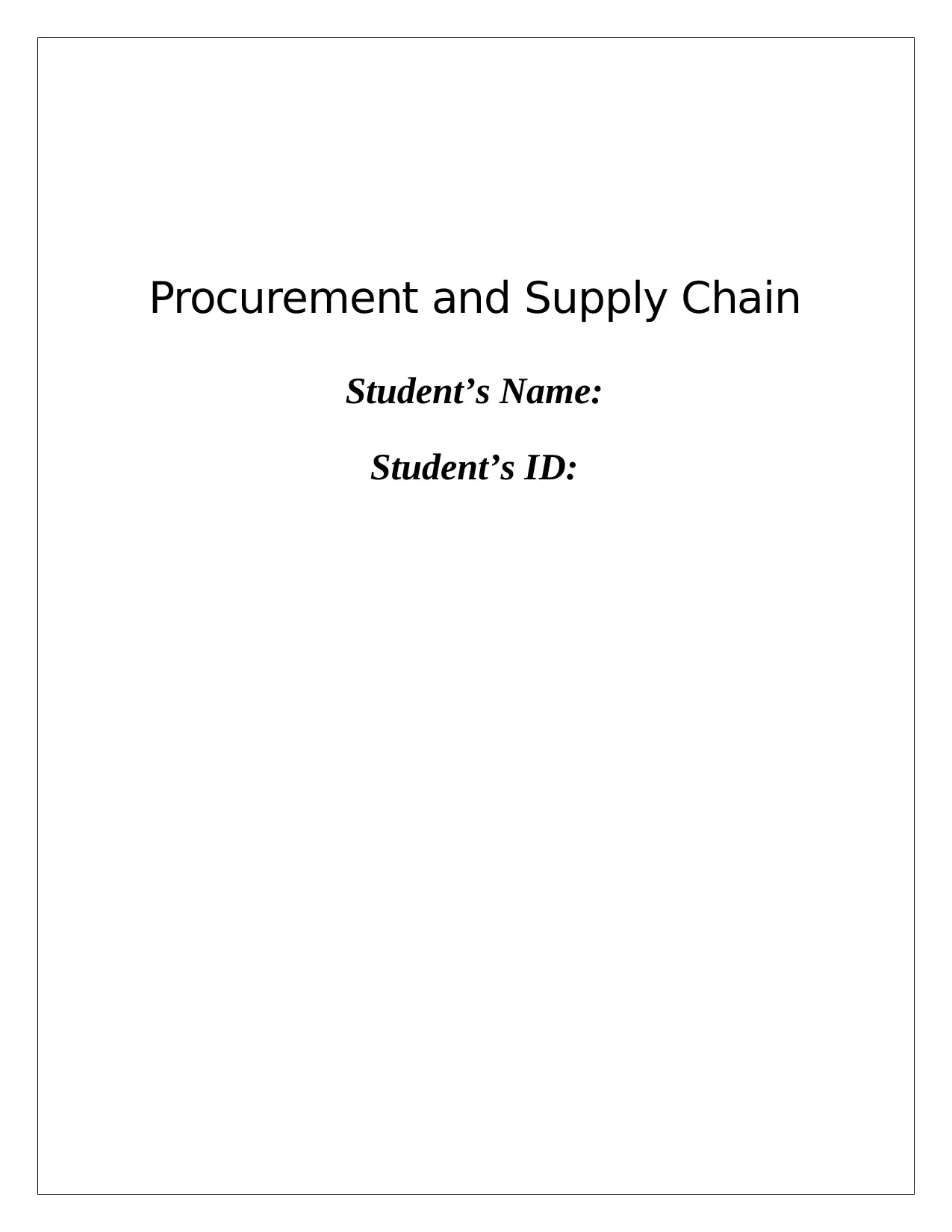
Procurement and Supply Chain
Student’s Name:
Student’s ID:
Student’s Name:
Student’s ID:
Secure Best Marks with AI Grader
Need help grading? Try our AI Grader for instant feedback on your assignments.
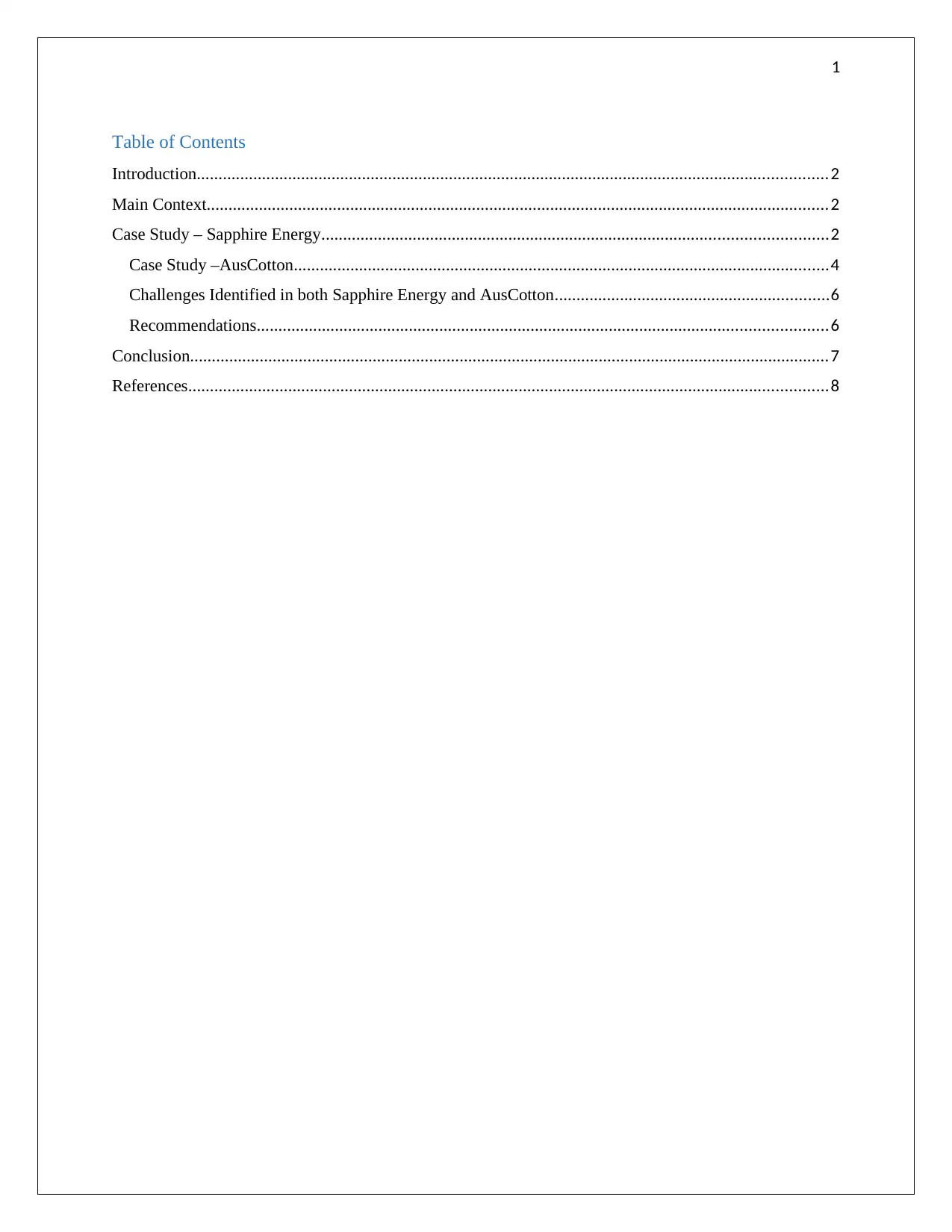
1
Table of Contents
Introduction.................................................................................................................................................2
Main Context...............................................................................................................................................2
Case Study – Sapphire Energy....................................................................................................................2
Case Study –AusCotton...........................................................................................................................4
Challenges Identified in both Sapphire Energy and AusCotton...............................................................6
Recommendations...................................................................................................................................6
Conclusion...................................................................................................................................................7
References...................................................................................................................................................8
Table of Contents
Introduction.................................................................................................................................................2
Main Context...............................................................................................................................................2
Case Study – Sapphire Energy....................................................................................................................2
Case Study –AusCotton...........................................................................................................................4
Challenges Identified in both Sapphire Energy and AusCotton...............................................................6
Recommendations...................................................................................................................................6
Conclusion...................................................................................................................................................7
References...................................................................................................................................................8
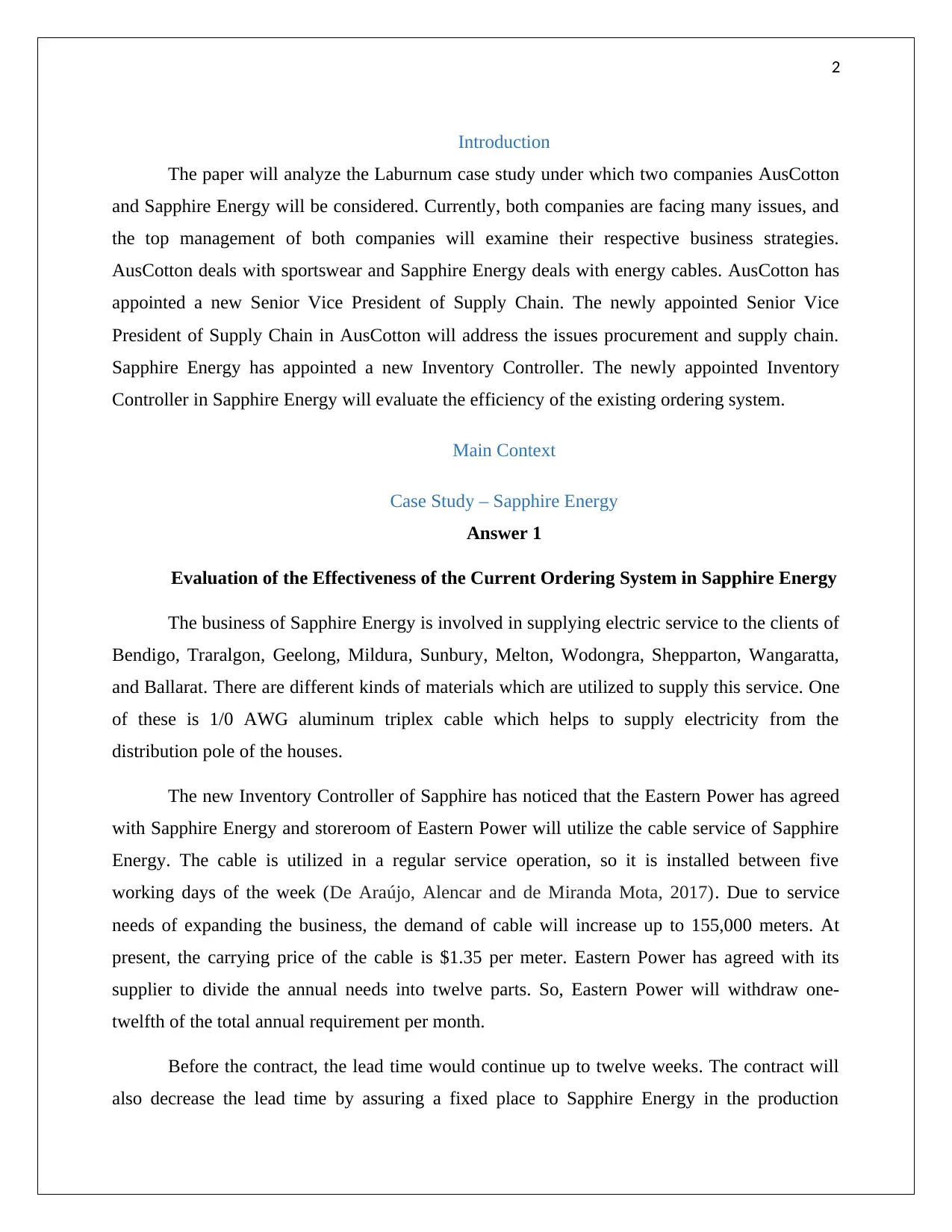
2
Introduction
The paper will analyze the Laburnum case study under which two companies AusCotton
and Sapphire Energy will be considered. Currently, both companies are facing many issues, and
the top management of both companies will examine their respective business strategies.
AusCotton deals with sportswear and Sapphire Energy deals with energy cables. AusCotton has
appointed a new Senior Vice President of Supply Chain. The newly appointed Senior Vice
President of Supply Chain in AusCotton will address the issues procurement and supply chain.
Sapphire Energy has appointed a new Inventory Controller. The newly appointed Inventory
Controller in Sapphire Energy will evaluate the efficiency of the existing ordering system.
Main Context
Case Study – Sapphire Energy
Answer 1
Evaluation of the Effectiveness of the Current Ordering System in Sapphire Energy
The business of Sapphire Energy is involved in supplying electric service to the clients of
Bendigo, Traralgon, Geelong, Mildura, Sunbury, Melton, Wodongra, Shepparton, Wangaratta,
and Ballarat. There are different kinds of materials which are utilized to supply this service. One
of these is 1/0 AWG aluminum triplex cable which helps to supply electricity from the
distribution pole of the houses.
The new Inventory Controller of Sapphire has noticed that the Eastern Power has agreed
with Sapphire Energy and storeroom of Eastern Power will utilize the cable service of Sapphire
Energy. The cable is utilized in a regular service operation, so it is installed between five
working days of the week (De Araújo, Alencar and de Miranda Mota, 2017). Due to service
needs of expanding the business, the demand of cable will increase up to 155,000 meters. At
present, the carrying price of the cable is $1.35 per meter. Eastern Power has agreed with its
supplier to divide the annual needs into twelve parts. So, Eastern Power will withdraw one-
twelfth of the total annual requirement per month.
Before the contract, the lead time would continue up to twelve weeks. The contract will
also decrease the lead time by assuring a fixed place to Sapphire Energy in the production
Introduction
The paper will analyze the Laburnum case study under which two companies AusCotton
and Sapphire Energy will be considered. Currently, both companies are facing many issues, and
the top management of both companies will examine their respective business strategies.
AusCotton deals with sportswear and Sapphire Energy deals with energy cables. AusCotton has
appointed a new Senior Vice President of Supply Chain. The newly appointed Senior Vice
President of Supply Chain in AusCotton will address the issues procurement and supply chain.
Sapphire Energy has appointed a new Inventory Controller. The newly appointed Inventory
Controller in Sapphire Energy will evaluate the efficiency of the existing ordering system.
Main Context
Case Study – Sapphire Energy
Answer 1
Evaluation of the Effectiveness of the Current Ordering System in Sapphire Energy
The business of Sapphire Energy is involved in supplying electric service to the clients of
Bendigo, Traralgon, Geelong, Mildura, Sunbury, Melton, Wodongra, Shepparton, Wangaratta,
and Ballarat. There are different kinds of materials which are utilized to supply this service. One
of these is 1/0 AWG aluminum triplex cable which helps to supply electricity from the
distribution pole of the houses.
The new Inventory Controller of Sapphire has noticed that the Eastern Power has agreed
with Sapphire Energy and storeroom of Eastern Power will utilize the cable service of Sapphire
Energy. The cable is utilized in a regular service operation, so it is installed between five
working days of the week (De Araújo, Alencar and de Miranda Mota, 2017). Due to service
needs of expanding the business, the demand of cable will increase up to 155,000 meters. At
present, the carrying price of the cable is $1.35 per meter. Eastern Power has agreed with its
supplier to divide the annual needs into twelve parts. So, Eastern Power will withdraw one-
twelfth of the total annual requirement per month.
Before the contract, the lead time would continue up to twelve weeks. The contract will
also decrease the lead time by assuring a fixed place to Sapphire Energy in the production
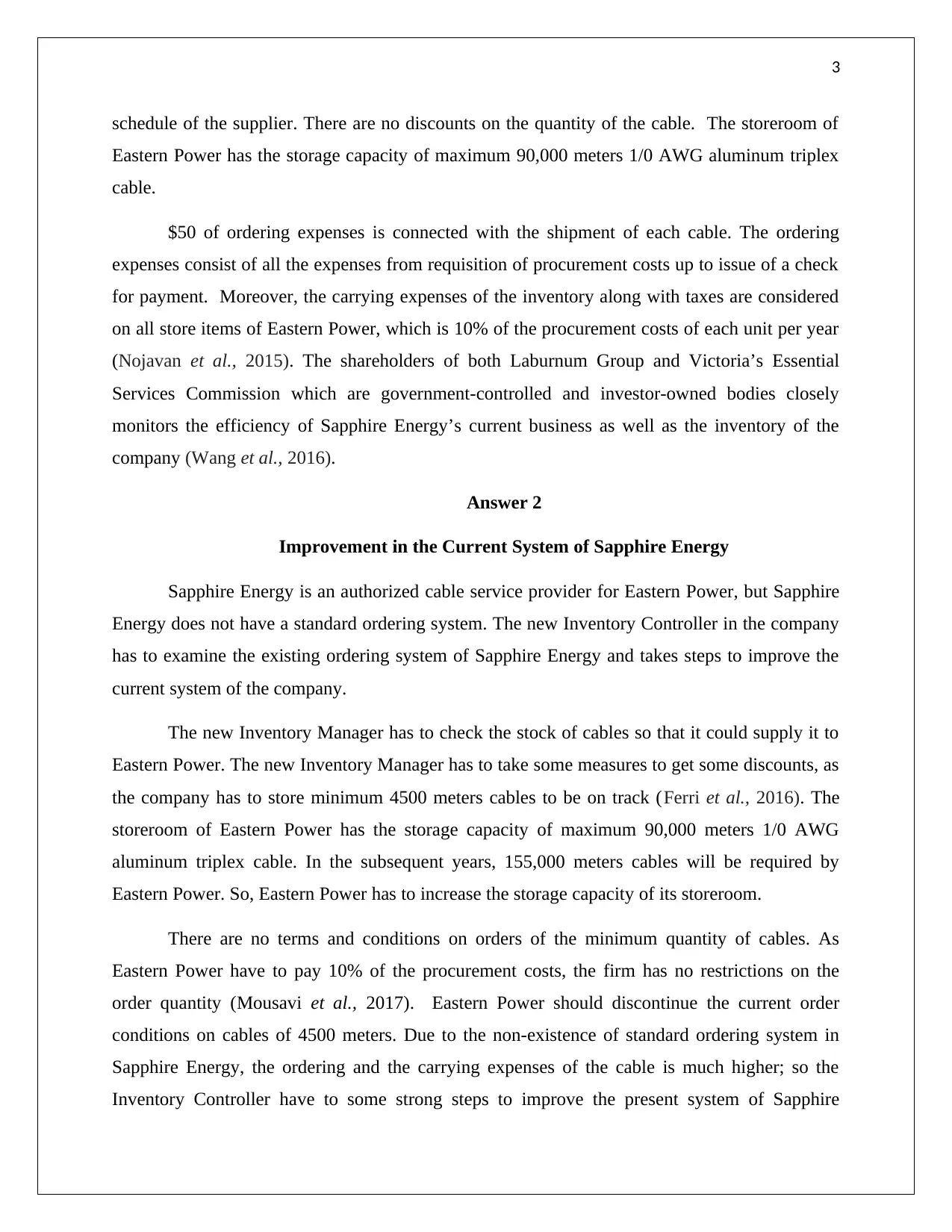
3
schedule of the supplier. There are no discounts on the quantity of the cable. The storeroom of
Eastern Power has the storage capacity of maximum 90,000 meters 1/0 AWG aluminum triplex
cable.
$50 of ordering expenses is connected with the shipment of each cable. The ordering
expenses consist of all the expenses from requisition of procurement costs up to issue of a check
for payment. Moreover, the carrying expenses of the inventory along with taxes are considered
on all store items of Eastern Power, which is 10% of the procurement costs of each unit per year
(Nojavan et al., 2015). The shareholders of both Laburnum Group and Victoria’s Essential
Services Commission which are government-controlled and investor-owned bodies closely
monitors the efficiency of Sapphire Energy’s current business as well as the inventory of the
company (Wang et al., 2016).
Answer 2
Improvement in the Current System of Sapphire Energy
Sapphire Energy is an authorized cable service provider for Eastern Power, but Sapphire
Energy does not have a standard ordering system. The new Inventory Controller in the company
has to examine the existing ordering system of Sapphire Energy and takes steps to improve the
current system of the company.
The new Inventory Manager has to check the stock of cables so that it could supply it to
Eastern Power. The new Inventory Manager has to take some measures to get some discounts, as
the company has to store minimum 4500 meters cables to be on track (Ferri et al., 2016). The
storeroom of Eastern Power has the storage capacity of maximum 90,000 meters 1/0 AWG
aluminum triplex cable. In the subsequent years, 155,000 meters cables will be required by
Eastern Power. So, Eastern Power has to increase the storage capacity of its storeroom.
There are no terms and conditions on orders of the minimum quantity of cables. As
Eastern Power have to pay 10% of the procurement costs, the firm has no restrictions on the
order quantity (Mousavi et al., 2017). Eastern Power should discontinue the current order
conditions on cables of 4500 meters. Due to the non-existence of standard ordering system in
Sapphire Energy, the ordering and the carrying expenses of the cable is much higher; so the
Inventory Controller have to some strong steps to improve the present system of Sapphire
schedule of the supplier. There are no discounts on the quantity of the cable. The storeroom of
Eastern Power has the storage capacity of maximum 90,000 meters 1/0 AWG aluminum triplex
cable.
$50 of ordering expenses is connected with the shipment of each cable. The ordering
expenses consist of all the expenses from requisition of procurement costs up to issue of a check
for payment. Moreover, the carrying expenses of the inventory along with taxes are considered
on all store items of Eastern Power, which is 10% of the procurement costs of each unit per year
(Nojavan et al., 2015). The shareholders of both Laburnum Group and Victoria’s Essential
Services Commission which are government-controlled and investor-owned bodies closely
monitors the efficiency of Sapphire Energy’s current business as well as the inventory of the
company (Wang et al., 2016).
Answer 2
Improvement in the Current System of Sapphire Energy
Sapphire Energy is an authorized cable service provider for Eastern Power, but Sapphire
Energy does not have a standard ordering system. The new Inventory Controller in the company
has to examine the existing ordering system of Sapphire Energy and takes steps to improve the
current system of the company.
The new Inventory Manager has to check the stock of cables so that it could supply it to
Eastern Power. The new Inventory Manager has to take some measures to get some discounts, as
the company has to store minimum 4500 meters cables to be on track (Ferri et al., 2016). The
storeroom of Eastern Power has the storage capacity of maximum 90,000 meters 1/0 AWG
aluminum triplex cable. In the subsequent years, 155,000 meters cables will be required by
Eastern Power. So, Eastern Power has to increase the storage capacity of its storeroom.
There are no terms and conditions on orders of the minimum quantity of cables. As
Eastern Power have to pay 10% of the procurement costs, the firm has no restrictions on the
order quantity (Mousavi et al., 2017). Eastern Power should discontinue the current order
conditions on cables of 4500 meters. Due to the non-existence of standard ordering system in
Sapphire Energy, the ordering and the carrying expenses of the cable is much higher; so the
Inventory Controller have to some strong steps to improve the present system of Sapphire
Secure Best Marks with AI Grader
Need help grading? Try our AI Grader for instant feedback on your assignments.
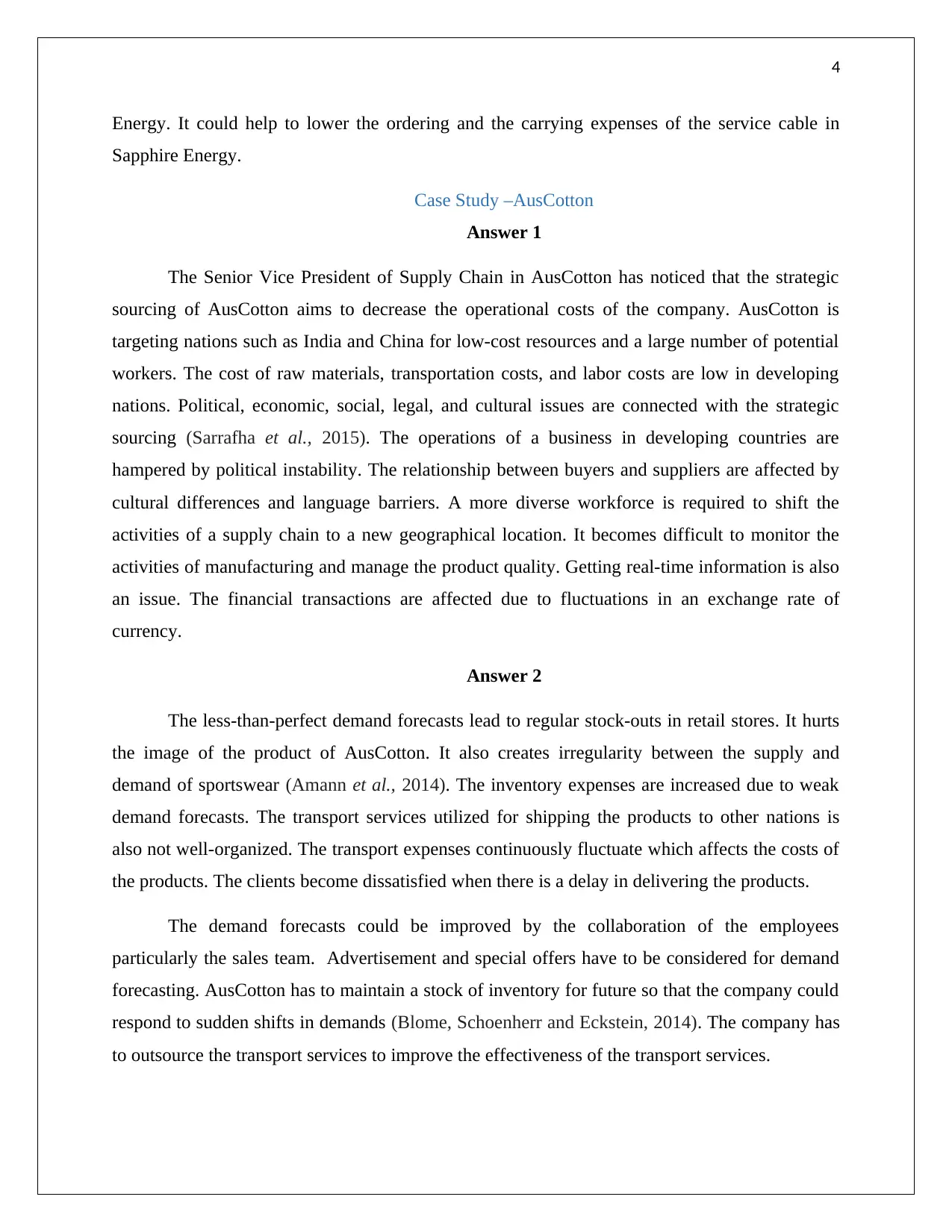
4
Energy. It could help to lower the ordering and the carrying expenses of the service cable in
Sapphire Energy.
Case Study –AusCotton
Answer 1
The Senior Vice President of Supply Chain in AusCotton has noticed that the strategic
sourcing of AusCotton aims to decrease the operational costs of the company. AusCotton is
targeting nations such as India and China for low-cost resources and a large number of potential
workers. The cost of raw materials, transportation costs, and labor costs are low in developing
nations. Political, economic, social, legal, and cultural issues are connected with the strategic
sourcing (Sarrafha et al., 2015). The operations of a business in developing countries are
hampered by political instability. The relationship between buyers and suppliers are affected by
cultural differences and language barriers. A more diverse workforce is required to shift the
activities of a supply chain to a new geographical location. It becomes difficult to monitor the
activities of manufacturing and manage the product quality. Getting real-time information is also
an issue. The financial transactions are affected due to fluctuations in an exchange rate of
currency.
Answer 2
The less-than-perfect demand forecasts lead to regular stock-outs in retail stores. It hurts
the image of the product of AusCotton. It also creates irregularity between the supply and
demand of sportswear (Amann et al., 2014). The inventory expenses are increased due to weak
demand forecasts. The transport services utilized for shipping the products to other nations is
also not well-organized. The transport expenses continuously fluctuate which affects the costs of
the products. The clients become dissatisfied when there is a delay in delivering the products.
The demand forecasts could be improved by the collaboration of the employees
particularly the sales team. Advertisement and special offers have to be considered for demand
forecasting. AusCotton has to maintain a stock of inventory for future so that the company could
respond to sudden shifts in demands (Blome, Schoenherr and Eckstein, 2014). The company has
to outsource the transport services to improve the effectiveness of the transport services.
Energy. It could help to lower the ordering and the carrying expenses of the service cable in
Sapphire Energy.
Case Study –AusCotton
Answer 1
The Senior Vice President of Supply Chain in AusCotton has noticed that the strategic
sourcing of AusCotton aims to decrease the operational costs of the company. AusCotton is
targeting nations such as India and China for low-cost resources and a large number of potential
workers. The cost of raw materials, transportation costs, and labor costs are low in developing
nations. Political, economic, social, legal, and cultural issues are connected with the strategic
sourcing (Sarrafha et al., 2015). The operations of a business in developing countries are
hampered by political instability. The relationship between buyers and suppliers are affected by
cultural differences and language barriers. A more diverse workforce is required to shift the
activities of a supply chain to a new geographical location. It becomes difficult to monitor the
activities of manufacturing and manage the product quality. Getting real-time information is also
an issue. The financial transactions are affected due to fluctuations in an exchange rate of
currency.
Answer 2
The less-than-perfect demand forecasts lead to regular stock-outs in retail stores. It hurts
the image of the product of AusCotton. It also creates irregularity between the supply and
demand of sportswear (Amann et al., 2014). The inventory expenses are increased due to weak
demand forecasts. The transport services utilized for shipping the products to other nations is
also not well-organized. The transport expenses continuously fluctuate which affects the costs of
the products. The clients become dissatisfied when there is a delay in delivering the products.
The demand forecasts could be improved by the collaboration of the employees
particularly the sales team. Advertisement and special offers have to be considered for demand
forecasting. AusCotton has to maintain a stock of inventory for future so that the company could
respond to sudden shifts in demands (Blome, Schoenherr and Eckstein, 2014). The company has
to outsource the transport services to improve the effectiveness of the transport services.
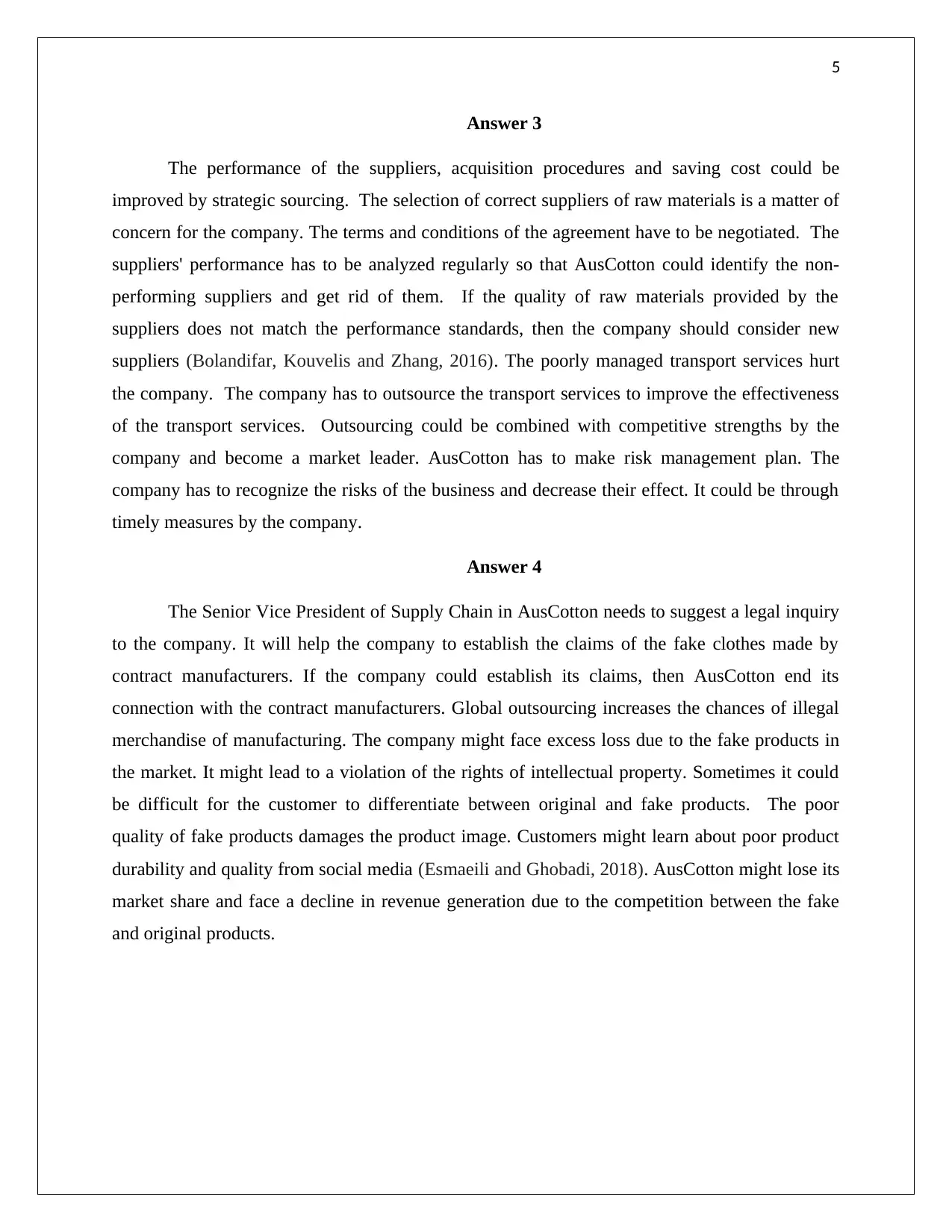
5
Answer 3
The performance of the suppliers, acquisition procedures and saving cost could be
improved by strategic sourcing. The selection of correct suppliers of raw materials is a matter of
concern for the company. The terms and conditions of the agreement have to be negotiated. The
suppliers' performance has to be analyzed regularly so that AusCotton could identify the non-
performing suppliers and get rid of them. If the quality of raw materials provided by the
suppliers does not match the performance standards, then the company should consider new
suppliers (Bolandifar, Kouvelis and Zhang, 2016). The poorly managed transport services hurt
the company. The company has to outsource the transport services to improve the effectiveness
of the transport services. Outsourcing could be combined with competitive strengths by the
company and become a market leader. AusCotton has to make risk management plan. The
company has to recognize the risks of the business and decrease their effect. It could be through
timely measures by the company.
Answer 4
The Senior Vice President of Supply Chain in AusCotton needs to suggest a legal inquiry
to the company. It will help the company to establish the claims of the fake clothes made by
contract manufacturers. If the company could establish its claims, then AusCotton end its
connection with the contract manufacturers. Global outsourcing increases the chances of illegal
merchandise of manufacturing. The company might face excess loss due to the fake products in
the market. It might lead to a violation of the rights of intellectual property. Sometimes it could
be difficult for the customer to differentiate between original and fake products. The poor
quality of fake products damages the product image. Customers might learn about poor product
durability and quality from social media (Esmaeili and Ghobadi, 2018). AusCotton might lose its
market share and face a decline in revenue generation due to the competition between the fake
and original products.
Answer 3
The performance of the suppliers, acquisition procedures and saving cost could be
improved by strategic sourcing. The selection of correct suppliers of raw materials is a matter of
concern for the company. The terms and conditions of the agreement have to be negotiated. The
suppliers' performance has to be analyzed regularly so that AusCotton could identify the non-
performing suppliers and get rid of them. If the quality of raw materials provided by the
suppliers does not match the performance standards, then the company should consider new
suppliers (Bolandifar, Kouvelis and Zhang, 2016). The poorly managed transport services hurt
the company. The company has to outsource the transport services to improve the effectiveness
of the transport services. Outsourcing could be combined with competitive strengths by the
company and become a market leader. AusCotton has to make risk management plan. The
company has to recognize the risks of the business and decrease their effect. It could be through
timely measures by the company.
Answer 4
The Senior Vice President of Supply Chain in AusCotton needs to suggest a legal inquiry
to the company. It will help the company to establish the claims of the fake clothes made by
contract manufacturers. If the company could establish its claims, then AusCotton end its
connection with the contract manufacturers. Global outsourcing increases the chances of illegal
merchandise of manufacturing. The company might face excess loss due to the fake products in
the market. It might lead to a violation of the rights of intellectual property. Sometimes it could
be difficult for the customer to differentiate between original and fake products. The poor
quality of fake products damages the product image. Customers might learn about poor product
durability and quality from social media (Esmaeili and Ghobadi, 2018). AusCotton might lose its
market share and face a decline in revenue generation due to the competition between the fake
and original products.
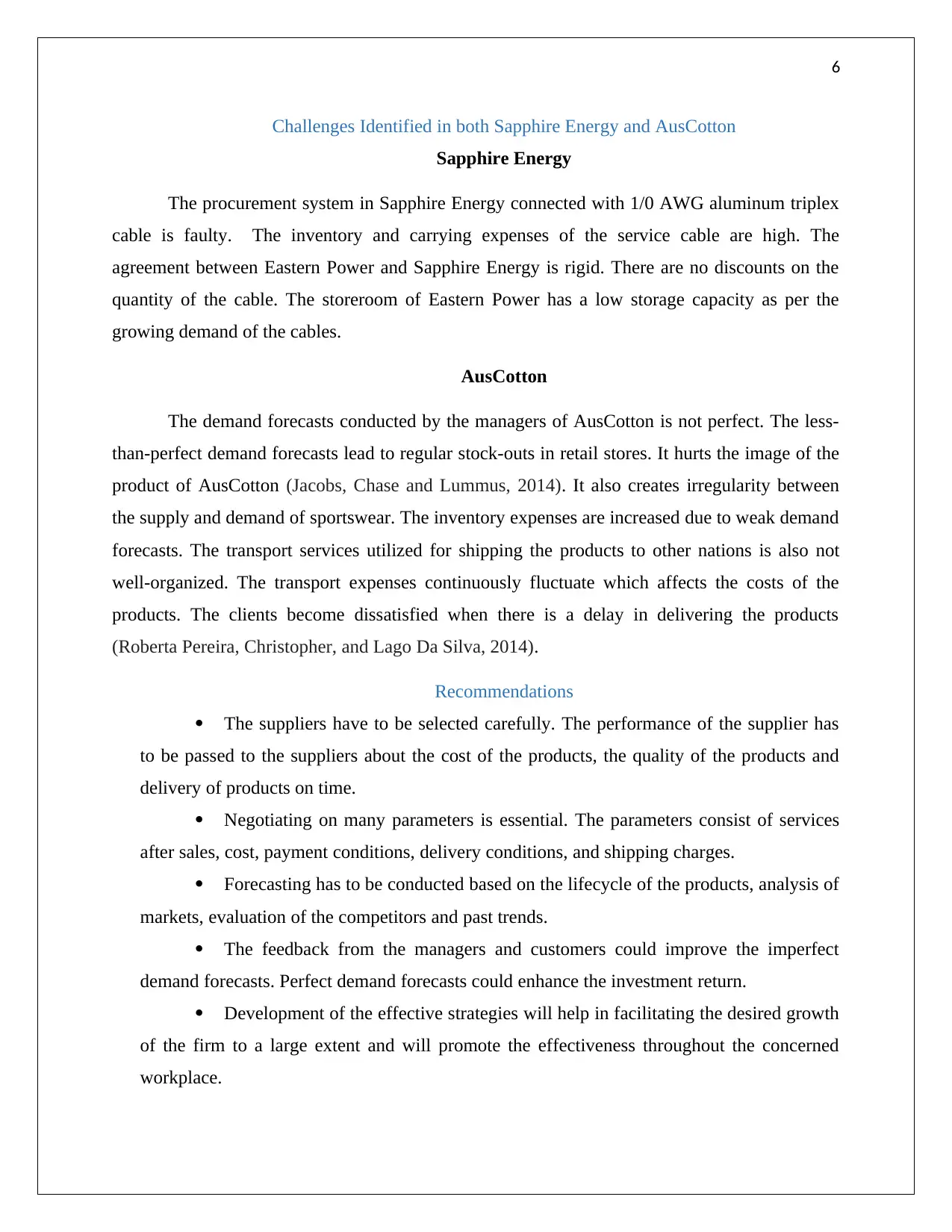
6
Challenges Identified in both Sapphire Energy and AusCotton
Sapphire Energy
The procurement system in Sapphire Energy connected with 1/0 AWG aluminum triplex
cable is faulty. The inventory and carrying expenses of the service cable are high. The
agreement between Eastern Power and Sapphire Energy is rigid. There are no discounts on the
quantity of the cable. The storeroom of Eastern Power has a low storage capacity as per the
growing demand of the cables.
AusCotton
The demand forecasts conducted by the managers of AusCotton is not perfect. The less-
than-perfect demand forecasts lead to regular stock-outs in retail stores. It hurts the image of the
product of AusCotton (Jacobs, Chase and Lummus, 2014). It also creates irregularity between
the supply and demand of sportswear. The inventory expenses are increased due to weak demand
forecasts. The transport services utilized for shipping the products to other nations is also not
well-organized. The transport expenses continuously fluctuate which affects the costs of the
products. The clients become dissatisfied when there is a delay in delivering the products
(Roberta Pereira, Christopher, and Lago Da Silva, 2014).
Recommendations
The suppliers have to be selected carefully. The performance of the supplier has
to be passed to the suppliers about the cost of the products, the quality of the products and
delivery of products on time.
Negotiating on many parameters is essential. The parameters consist of services
after sales, cost, payment conditions, delivery conditions, and shipping charges.
Forecasting has to be conducted based on the lifecycle of the products, analysis of
markets, evaluation of the competitors and past trends.
The feedback from the managers and customers could improve the imperfect
demand forecasts. Perfect demand forecasts could enhance the investment return.
Development of the effective strategies will help in facilitating the desired growth
of the firm to a large extent and will promote the effectiveness throughout the concerned
workplace.
Challenges Identified in both Sapphire Energy and AusCotton
Sapphire Energy
The procurement system in Sapphire Energy connected with 1/0 AWG aluminum triplex
cable is faulty. The inventory and carrying expenses of the service cable are high. The
agreement between Eastern Power and Sapphire Energy is rigid. There are no discounts on the
quantity of the cable. The storeroom of Eastern Power has a low storage capacity as per the
growing demand of the cables.
AusCotton
The demand forecasts conducted by the managers of AusCotton is not perfect. The less-
than-perfect demand forecasts lead to regular stock-outs in retail stores. It hurts the image of the
product of AusCotton (Jacobs, Chase and Lummus, 2014). It also creates irregularity between
the supply and demand of sportswear. The inventory expenses are increased due to weak demand
forecasts. The transport services utilized for shipping the products to other nations is also not
well-organized. The transport expenses continuously fluctuate which affects the costs of the
products. The clients become dissatisfied when there is a delay in delivering the products
(Roberta Pereira, Christopher, and Lago Da Silva, 2014).
Recommendations
The suppliers have to be selected carefully. The performance of the supplier has
to be passed to the suppliers about the cost of the products, the quality of the products and
delivery of products on time.
Negotiating on many parameters is essential. The parameters consist of services
after sales, cost, payment conditions, delivery conditions, and shipping charges.
Forecasting has to be conducted based on the lifecycle of the products, analysis of
markets, evaluation of the competitors and past trends.
The feedback from the managers and customers could improve the imperfect
demand forecasts. Perfect demand forecasts could enhance the investment return.
Development of the effective strategies will help in facilitating the desired growth
of the firm to a large extent and will promote the effectiveness throughout the concerned
workplace.
Paraphrase This Document
Need a fresh take? Get an instant paraphrase of this document with our AI Paraphraser
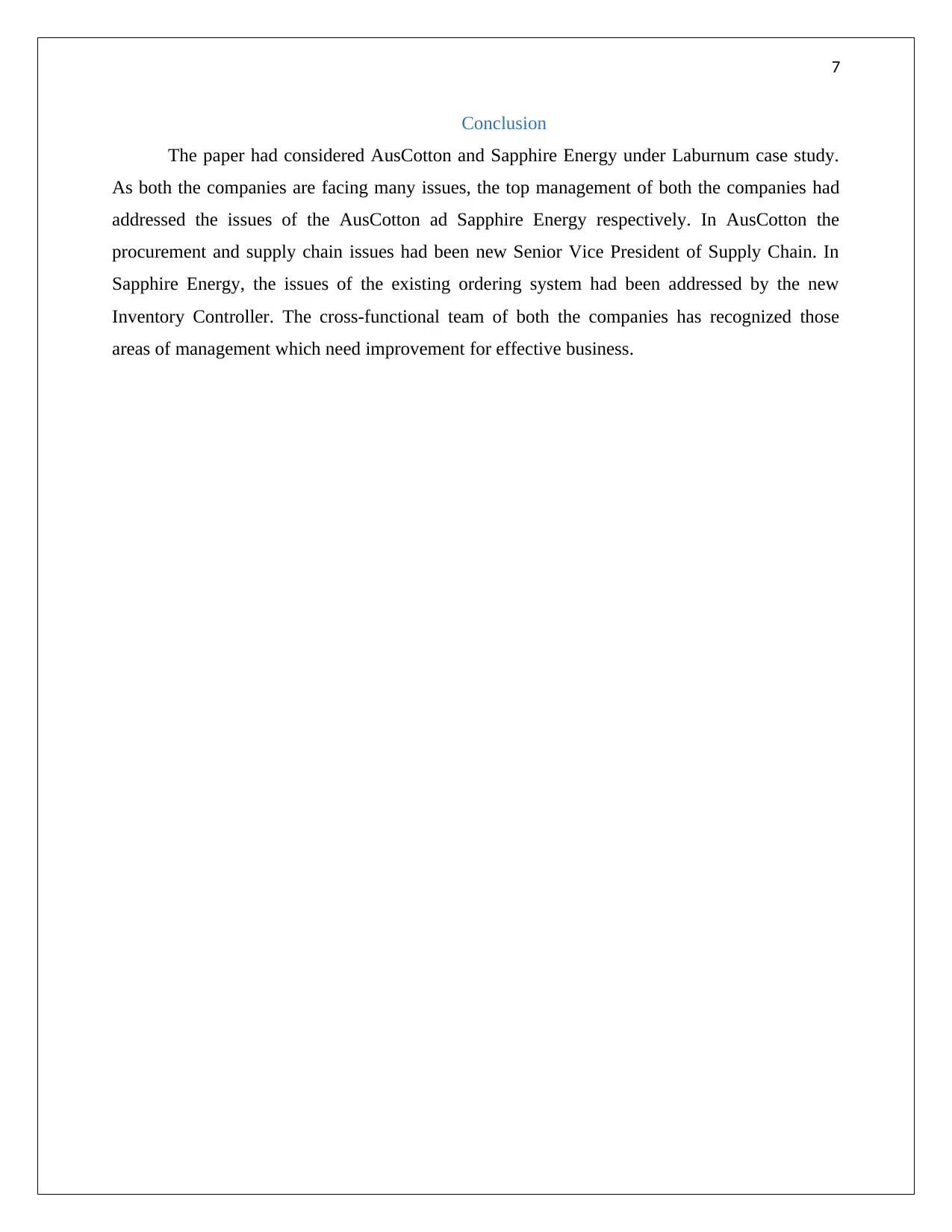
7
Conclusion
The paper had considered AusCotton and Sapphire Energy under Laburnum case study.
As both the companies are facing many issues, the top management of both the companies had
addressed the issues of the AusCotton ad Sapphire Energy respectively. In AusCotton the
procurement and supply chain issues had been new Senior Vice President of Supply Chain. In
Sapphire Energy, the issues of the existing ordering system had been addressed by the new
Inventory Controller. The cross-functional team of both the companies has recognized those
areas of management which need improvement for effective business.
Conclusion
The paper had considered AusCotton and Sapphire Energy under Laburnum case study.
As both the companies are facing many issues, the top management of both the companies had
addressed the issues of the AusCotton ad Sapphire Energy respectively. In AusCotton the
procurement and supply chain issues had been new Senior Vice President of Supply Chain. In
Sapphire Energy, the issues of the existing ordering system had been addressed by the new
Inventory Controller. The cross-functional team of both the companies has recognized those
areas of management which need improvement for effective business.
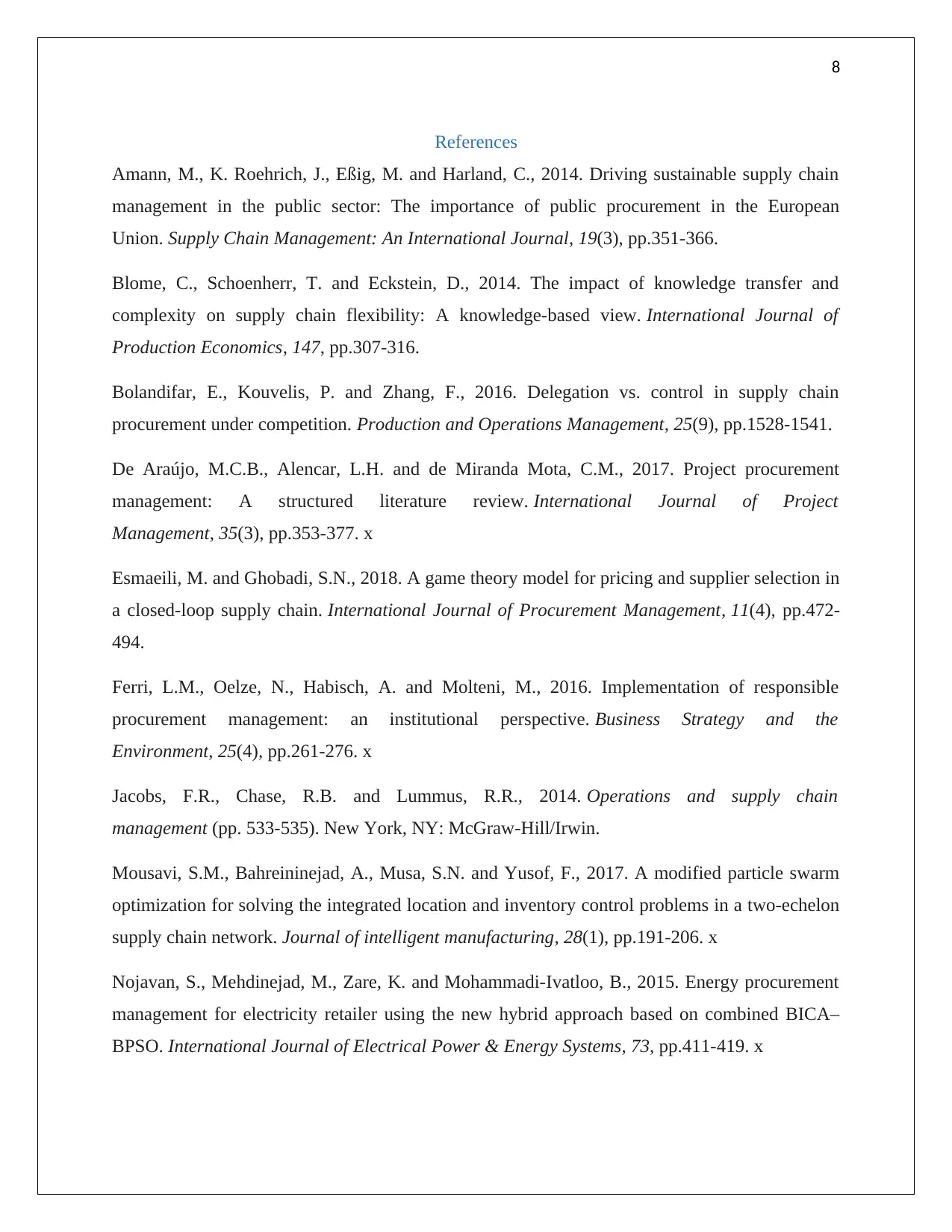
8
References
Amann, M., K. Roehrich, J., Eßig, M. and Harland, C., 2014. Driving sustainable supply chain
management in the public sector: The importance of public procurement in the European
Union. Supply Chain Management: An International Journal, 19(3), pp.351-366.
Blome, C., Schoenherr, T. and Eckstein, D., 2014. The impact of knowledge transfer and
complexity on supply chain flexibility: A knowledge-based view. International Journal of
Production Economics, 147, pp.307-316.
Bolandifar, E., Kouvelis, P. and Zhang, F., 2016. Delegation vs. control in supply chain
procurement under competition. Production and Operations Management, 25(9), pp.1528-1541.
De Araújo, M.C.B., Alencar, L.H. and de Miranda Mota, C.M., 2017. Project procurement
management: A structured literature review. International Journal of Project
Management, 35(3), pp.353-377. x
Esmaeili, M. and Ghobadi, S.N., 2018. A game theory model for pricing and supplier selection in
a closed-loop supply chain. International Journal of Procurement Management, 11(4), pp.472-
494.
Ferri, L.M., Oelze, N., Habisch, A. and Molteni, M., 2016. Implementation of responsible
procurement management: an institutional perspective. Business Strategy and the
Environment, 25(4), pp.261-276. x
Jacobs, F.R., Chase, R.B. and Lummus, R.R., 2014. Operations and supply chain
management (pp. 533-535). New York, NY: McGraw-Hill/Irwin.
Mousavi, S.M., Bahreininejad, A., Musa, S.N. and Yusof, F., 2017. A modified particle swarm
optimization for solving the integrated location and inventory control problems in a two-echelon
supply chain network. Journal of intelligent manufacturing, 28(1), pp.191-206. x
Nojavan, S., Mehdinejad, M., Zare, K. and Mohammadi-Ivatloo, B., 2015. Energy procurement
management for electricity retailer using the new hybrid approach based on combined BICA–
BPSO. International Journal of Electrical Power & Energy Systems, 73, pp.411-419. x
References
Amann, M., K. Roehrich, J., Eßig, M. and Harland, C., 2014. Driving sustainable supply chain
management in the public sector: The importance of public procurement in the European
Union. Supply Chain Management: An International Journal, 19(3), pp.351-366.
Blome, C., Schoenherr, T. and Eckstein, D., 2014. The impact of knowledge transfer and
complexity on supply chain flexibility: A knowledge-based view. International Journal of
Production Economics, 147, pp.307-316.
Bolandifar, E., Kouvelis, P. and Zhang, F., 2016. Delegation vs. control in supply chain
procurement under competition. Production and Operations Management, 25(9), pp.1528-1541.
De Araújo, M.C.B., Alencar, L.H. and de Miranda Mota, C.M., 2017. Project procurement
management: A structured literature review. International Journal of Project
Management, 35(3), pp.353-377. x
Esmaeili, M. and Ghobadi, S.N., 2018. A game theory model for pricing and supplier selection in
a closed-loop supply chain. International Journal of Procurement Management, 11(4), pp.472-
494.
Ferri, L.M., Oelze, N., Habisch, A. and Molteni, M., 2016. Implementation of responsible
procurement management: an institutional perspective. Business Strategy and the
Environment, 25(4), pp.261-276. x
Jacobs, F.R., Chase, R.B. and Lummus, R.R., 2014. Operations and supply chain
management (pp. 533-535). New York, NY: McGraw-Hill/Irwin.
Mousavi, S.M., Bahreininejad, A., Musa, S.N. and Yusof, F., 2017. A modified particle swarm
optimization for solving the integrated location and inventory control problems in a two-echelon
supply chain network. Journal of intelligent manufacturing, 28(1), pp.191-206. x
Nojavan, S., Mehdinejad, M., Zare, K. and Mohammadi-Ivatloo, B., 2015. Energy procurement
management for electricity retailer using the new hybrid approach based on combined BICA–
BPSO. International Journal of Electrical Power & Energy Systems, 73, pp.411-419. x
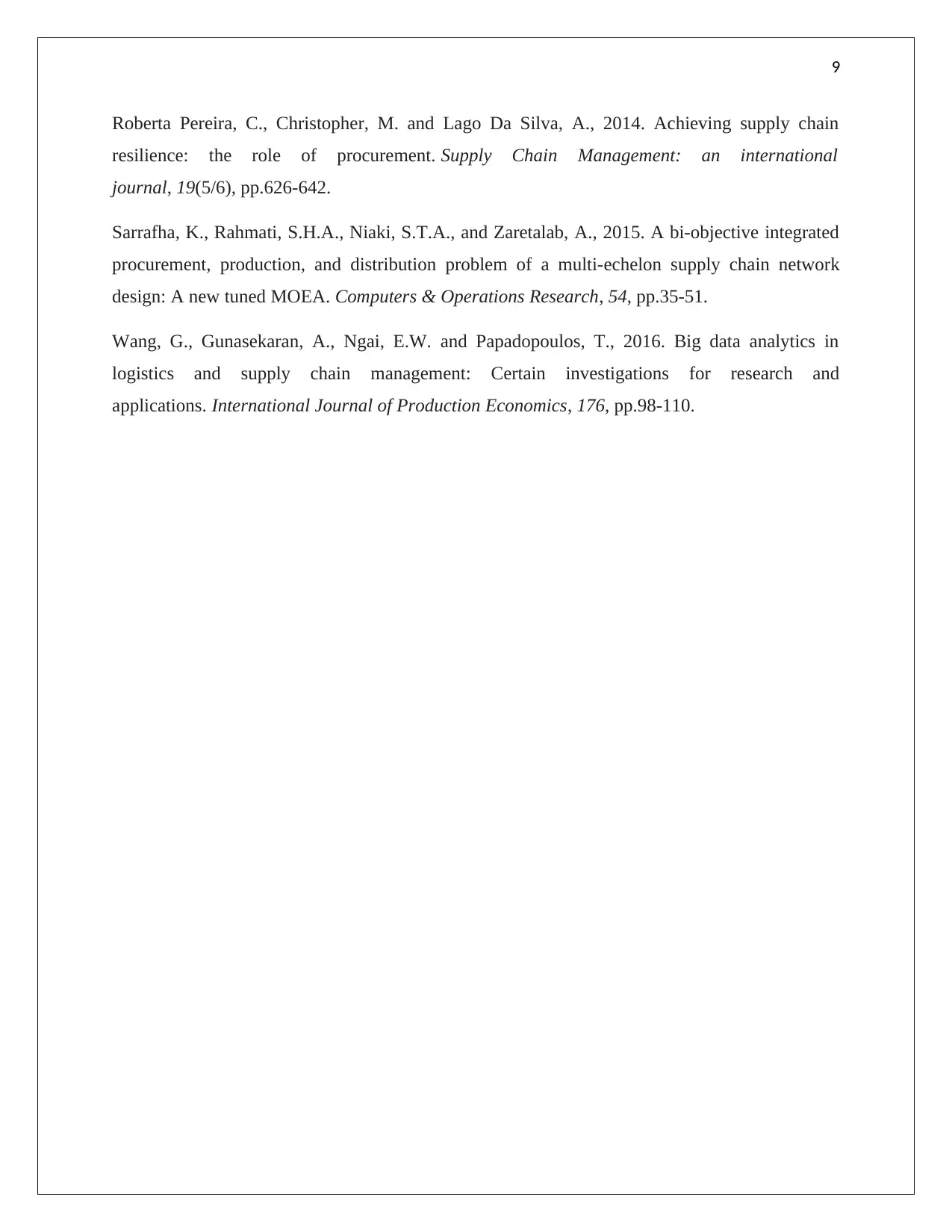
9
Roberta Pereira, C., Christopher, M. and Lago Da Silva, A., 2014. Achieving supply chain
resilience: the role of procurement. Supply Chain Management: an international
journal, 19(5/6), pp.626-642.
Sarrafha, K., Rahmati, S.H.A., Niaki, S.T.A., and Zaretalab, A., 2015. A bi-objective integrated
procurement, production, and distribution problem of a multi-echelon supply chain network
design: A new tuned MOEA. Computers & Operations Research, 54, pp.35-51.
Wang, G., Gunasekaran, A., Ngai, E.W. and Papadopoulos, T., 2016. Big data analytics in
logistics and supply chain management: Certain investigations for research and
applications. International Journal of Production Economics, 176, pp.98-110.
Roberta Pereira, C., Christopher, M. and Lago Da Silva, A., 2014. Achieving supply chain
resilience: the role of procurement. Supply Chain Management: an international
journal, 19(5/6), pp.626-642.
Sarrafha, K., Rahmati, S.H.A., Niaki, S.T.A., and Zaretalab, A., 2015. A bi-objective integrated
procurement, production, and distribution problem of a multi-echelon supply chain network
design: A new tuned MOEA. Computers & Operations Research, 54, pp.35-51.
Wang, G., Gunasekaran, A., Ngai, E.W. and Papadopoulos, T., 2016. Big data analytics in
logistics and supply chain management: Certain investigations for research and
applications. International Journal of Production Economics, 176, pp.98-110.
1 out of 10
Related Documents
Your All-in-One AI-Powered Toolkit for Academic Success.
+13062052269
info@desklib.com
Available 24*7 on WhatsApp / Email
![[object Object]](/_next/static/media/star-bottom.7253800d.svg)
Unlock your academic potential
© 2024 | Zucol Services PVT LTD | All rights reserved.




